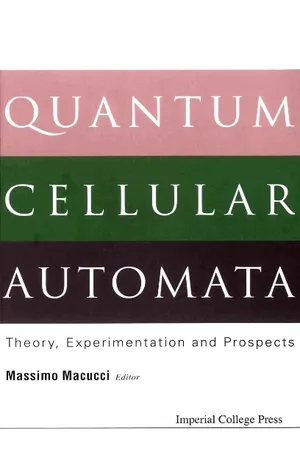
Quantum Cellular Automata: Theory, Experimentation And Prospects
Theory, Experimentation and Prospects
- 300 pages
- English
- PDF
- Available on iOS & Android
Quantum Cellular Automata: Theory, Experimentation And Prospects
Theory, Experimentation and Prospects
About this book
The Quantum Cellular Automaton (QCA) concept represents an attempt to break away from the traditional three-terminal device paradigm that has dominated digital computation. Since its early formulation in 1993 at Notre Dame University, the QCA idea has received significant attention and several physical implementations have been proposed.This book provides a comprehensive discussion of the simulation approaches and the experimental work that have been undertaken on the fabrication of devices capable of demonstrating the fundamentals of QCA action. Complementary views of future perspectives for QCA technology are presented, highlighting a process of realistic simulation and of targeted experiments that can be assumed as a model for the evaluation of future device proposals.
Frequently asked questions
- Essential is ideal for learners and professionals who enjoy exploring a wide range of subjects. Access the Essential Library with 800,000+ trusted titles and best-sellers across business, personal growth, and the humanities. Includes unlimited reading time and Standard Read Aloud voice.
- Complete: Perfect for advanced learners and researchers needing full, unrestricted access. Unlock 1.4M+ books across hundreds of subjects, including academic and specialized titles. The Complete Plan also includes advanced features like Premium Read Aloud and Research Assistant.
Please note we cannot support devices running on iOS 13 and Android 7 or earlier. Learn more about using the app.
Information
Table of contents
- CONTENTS
- Preface
- 1 The Concept of Quantum-Dot Cellular Automata
- 2 QCA Simulation with the Occupation-Number Hamiltonian
- 3 Realistic Time-Independent Models of a QCA Cell
- 4 Time-Independent Simulation of QCA Circuits
- 5 Simulation of the Time-Dependent Behavior of QCA Circuits with the Occupation-Number Hamiltonian
- 6 Time-Dependent Analysis of QCA Circuits with the Monte Carlo Method
- 7 Implementation of QCA Cells with SOI Technology
- 8 Implementation of QCA Cells in GaAs Technology
- 9 Non-Invasive Charge Detectors
- 10 Metal Dot QCA
- 11 Molecular QCA
- 12 Magnetic Quantum-Dot Cellular Automata (MQCA)
- 13 Final Remarks and Future Perspectives
- Index